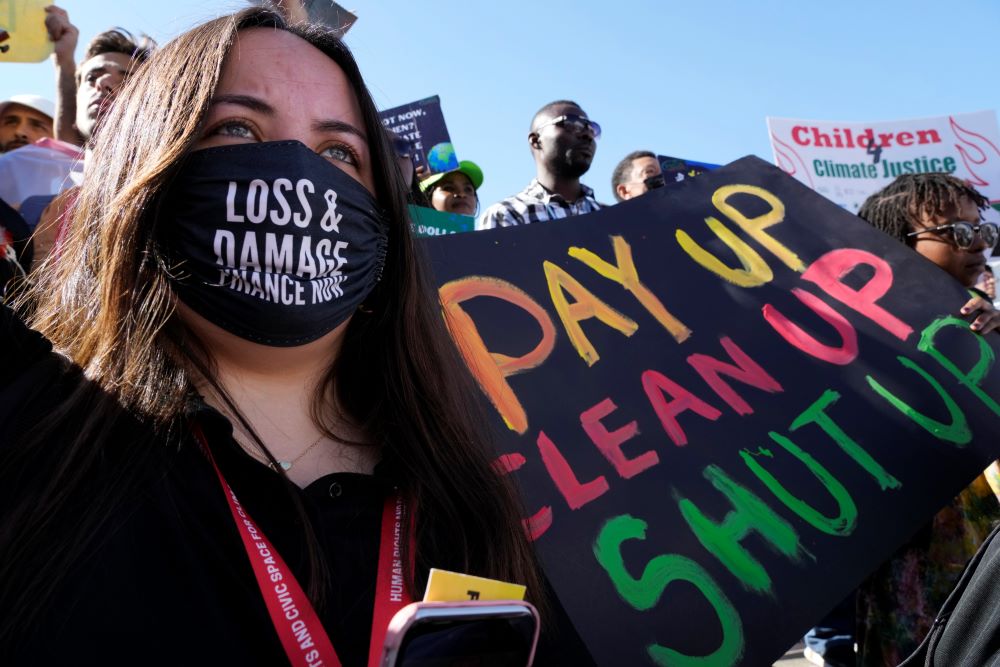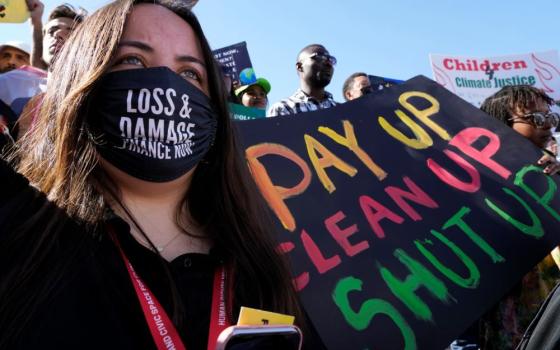
A demonstrator holds a sign that reads "pay up clean up shut up" during a protest at the COP27 U.N. Climate Summit Nov. 12 in Sharm el-Sheikh, Egypt. (AP/Peter Dejong)
Welcome to Burning Questions, the EarthBeat feature that takes on those questions smoldering in your mind about climate change and religion — from the basics to more complex, and everything in between. Have a Burning Question of your own? Let us know.
If you've followed the coverage coming out of the COP27 United Nations climate change conference in Sharm el-Sheikh, Egypt, you've likely heard this three-word phrase more than a few times: loss and damage.
The technical-sounding term has elevated in the discourse this year in international negotiations around the global response to climate change. But what does it mean, and why is it important?
We'll explore that, as well as what the Catholic Church has to say about it, in this Burning Question here at EarthBeat.
Exactly what is loss and damage?
Loss and damage generally refers to the adverse impacts of climate change that go beyond what communities and regions can adapt to or avoid. They are consequences associated with the level of global warming that has already occurred (roughly 1.1 to 1.2 degrees Celsius above preindustrial times) and are unavoidable due to the amount of greenhouse gases already emitted.
Think of communities where homes, businesses and infrastructure are decimated by catastrophic storms. Coastal areas and island nations losing land and fishing grounds as sea levels rise. Work hours and tourism dollars forfeited due to extreme weather.
Then there are non-economic losses, too, that can't be quantified, like the losses of culture and heritage, not to mention the loss of lives when wildfires, floods, droughts and storms wreak havoc upon a region. Burial grounds or religious sites that are now underwater. Droughts eroding traditional hunting grounds.
In U.N. climate talks, loss and damage adds a second component: compensation.
Flooded homes in Vohipeno, Madagascar, are pictured in an aerial view Feb. 7 in the aftermath of Cyclone Batsirai. (CNS/CRS/Miguel Rasolof)
People and areas facing these extreme climate impacts, led by island nations and developing countries, have argued that those who have contributed the most to climate change — wealthier nations, like the U.S., who grew their economies for decades from burning fossil fuels — have a responsibility to not only address the problem but also to provide assistance to communities that have suffered from extreme weather events caused or exacerbated by climate change.
Seth Borenstein, a reporter at The Associated Press climate desk, in a recent online briefing compared loss and damage to the concept of "polluter pays" in U.S. environmental policies: "If it's your yard, you shouldn't pay to clean up a mess you didn't make. I should clean it up if I dumped it there," he explained.
Some countries have framed this as climate reparations or compensation for the destruction they have already faced as the planet has heated. In these cases, they're likely talking about loss and damage.
'We are all responsible for climate change, and we should be all responsible for loss and damage as well.'
—Rado Ravonjiarivelo
Why is loss and damage important?
Loss and damage is important because climate change is already happening.
A report issued in February from the U.N. Intergovernmental Panel on Climate Change provided a sweeping picture of the present and future impacts of climate change, which it said already "has caused widespread adverse impacts and related losses and damages to nature and people, beyond natural climate variability" that have disproportionately affected the world's most vulnerable communities and have pushed some beyond their ability to adapt.
The scientific report estimated more than 3 billion people live in areas highly vulnerable to climate change, and millions face food insecurity due to rising temperatures. The IPCC listed parts of Africa, South Asia, Central and South America and island nations as regions especially vulnerable to climate change.
For countries and communities facing these consequences of global warming right now in their daily lives, the debate around loss and damage is not abstract — it's reality.
Take, for example, Madagascar.
For the past five years, the island country off Africa's southeastern coast has faced droughts in the south that have led to famine and loss of economically essential agricultural activities, says Rado Ravonjiarivelo, a compliance and climate integration program manager with Catholic Relief Services in the country. He was part of a COP27 event on loss and damage hosted by Caritas Internationalis and other faith-based organizations.
At the start of 2022, Madagascar was also slammed with five tropical storms in a two-month span. Even with some measures in place to mitigate or adapt to climate impacts, including ones introduced by CRS, the destruction represented 5% of the country's GDP, Ravonjiarivelo told EarthBeat.
"The importance of discussing the loss and damage is the fact that mitigation and adaptation is not sufficient for sustainable development, considering the fact that the intensity and the frequency of the climate events are higher now," he said.
According to data from Caritas Internationalis, when Tropical Cyclone Winston, a Category 5 storm, struck Fiji in 2016, it caused an estimated $1.42 billion in damages, or roughly 30% of its GDP, and impacted 540,000 people, including more than half of those reliant on agriculture.
During a pre-COP27 conference hosted by the Vatican, Fiji attorney general Aiyaz Sayed-Khaiyum described how the "havoc wrought" by climate change on lives, cultures, faiths and economies "is becoming increasingly commonplace" in his country and others.
"Loss and damage must not be allowed to become endemic and accepted as a residual cost of transition," he said, adding that steps are needed now to ensure it "does not become the sledgehammer that permanently divides the developed from the developing world."
A water level meter stands in the middle of the dried up Kondor Lake near Kerekegyhaza, Hungary, July 21. Farmers across Hungary have reported "historic" drought damage, the ministry of agriculture said. (CNS/Reuters/Marton Monus)
Is loss and damage controversial?
Loss and damage has been one of the most contentious points in the three decades of international climate negotiations.
Small island states first proposed the idea in the early 1990s, but it has been continually shut down or tabled at COP after COP. Even in breakthrough moments — like the inclusion of loss and damage in article 8 of the 2015 Paris Agreement, where countries agreed to "recognize the importance of averting, minimising and addressing loss and damage" — nations have not committed to do much about it, including establishing a financing mechanism.
Wealthier nations have been reluctant to acknowledge or support the idea of financial compensation for the impacts of climate change. Instead, much of the U.N. proceedings have focused on mitigation — reducing greenhouse gas emissions to limit global warming and prevent the worst-case scenarios — and adaptation to prepare communities and countries to withstand and build resilience to climate impacts. Far less attention has been paid to what to do about the losses and damages already suffered or that are unavoidable.
This has exposed one of the biggest fault lines between developed and developing countries in COP negotiations.
The U.S., as the world's largest historical emitter of greenhouse gases, has been particularly hesitant to loss and damage discussion over fears of liability, which could lead to lawsuits. Last year at COP26 in Glasgow it joined with the European Union in changing the final text from creating a financial fund for loss and damage to holding dialogues on financing options.
Even if countries agree on the need for loss and damage financing, how to gather and distribute funds is still a complex matter. How much is one country or company responsible for a climate-related disaster, who determines that and what is fair compensation? Or should countries pay into a fund proportionate to their historical carbon footprint? Who controls and administers the funds?
Volunteers try to extinguish a wildfire burning in the Greek village of Markati, near Athens, Aug. 16, 2021. Catholic leaders at COP27 were concerned that few world leaders have demonstrated progress in implementing their climate commitments or financial support for countries bearing the brunt of climate change. (CNS/Reuters/Alkis Konstantinidis)
A recent study by researchers at Dartmouth College, as reported by The AP, has started connecting one country's emissions to damage caused elsewhere, and attribution science is advancing in determining to what degree climate change contributes to individual storms and extreme weather.
But even those questions don't factor in the role the compensated country may have played as well, Ravonjiarivelo said. For instance, he explained that deforestation in Madagascar weakened barriers that could have lessened the impact of storms.
"We are all responsible for climate change, and we should be all responsible for loss and damage as well," he said.
What has the Catholic Church said about loss and damage?
Catholic humanitarian and development agencies like CRS have been at the forefront within the church in advocating for nations to address loss and damage.
Much of that stems from what their staff and partners witness on the ground in parts of the globe where climate change is upending livelihoods.
"We are seeing loss and damage of climate change in our daily work," Ravonjiarivelo told EarthBeat.
Along with CRS, Catholic groups like Caritas, CIDSE, Living Laudato Si' Philippines, Laudato Si' Movement, Maryknoll and Mercy Sisters have all advocated for nations to prioritize and address loss and damage, what they consider a matter of justice.
"Without a reliable and comprehensive financing facility to ensure funding to help countries cope with climate-induced loss and damage, the most vulnerable countries will sink deeper into debt and poverty every time they are hit by climate disasters, for which they are not responsible," Aloysius John, Caritas Internationalis secretary general, said ahead of COP27.
The Vatican, too, has prioritized a focus on loss and damage in recent years.
In his message to COP26, Pope Francis said that countries with greater means "need to take a leading role in the areas of climate finance," in decarbonization and adaptation to climate change in more vulnerable countries but also to help them "to respond to the loss and damage it has caused."
That call was reiterated in an unprecedented joint appeal from leaders of world religions, including the pope, that was issued before the Glasgow climate summit (and later displayed outside its main plenary halls).
Francis has frequently spoken about the "differentiated responsibilities" among countries in responding to climate change, and that developed countries have incurred an "ecological debt" through decades of fossil fueled-economic growth. In his encyclical "Laudato Si’, on Care for Our Common Home," he cited the U.S. bishops’ 2001 pastoral letter on climate change, which stated that greater attention must be given to "the needs of the poor, the weak and the vulnerable, in a debate often dominated by more powerful interests."
Cardinal Pietro Parolin, Vatican secretary of state, in his remarks at COP27 included loss and damage among four interconnected pillars of the Paris Agreement, adding "We should also not neglect the non-economic side of loss and damage, like loss of heritage and cultures."
In a COP27 policy position paper, CIDSE, a network of mostly European-based Catholic development organizations, listed loss and damage at the top of its key priorities.
Cardinal Pietro Parolin, Vatican secretary of state, addresses COP27, the 27th Conference of the Parties of the U.N. Framework Convention on Climate Change, in Sharm el-Sheikh, Egypt, Nov. 8. (CNS screenshot/UNFCCC)
A theological reflection on loss and damage, written by Jesuit Fr. Leonard Chiti, linked loss and damage with the preferential option for the poor in Catholic social teaching, stating, "As a faith community, our starting point is always the situation of the poor and how it is impacted by such issues as climate change."
"We cannot focus exclusively on mitigation and adaptation as this does not fully take into account the needs of the poor in relation to climate change," he wrote. "Loss and Damage is a priority issue for the poor, it is the poor who are most affected by it between states and within states, and the current global climate architecture is failing the poor by not providing finance for this issue."
Chiti added that the non-economic loss and damage from climate change "should be a clarion call for Catholic actors to prioritise action on this issue."
"God's creation, His planet and His people, are being irrevocably changed by anthropogenic climate change, causing distress, trauma and suffering to millions. … It is our duty as Catholics, therefore, to call for an adequate response to Loss and Damage," he wrote.
The COP27 sign is displayed along a road leading to the conference area in Egypt's Red Sea resort of Sharm el-Sheikh, the host of Nov.6-18 COP27 summit. (CNS/Reuters/Sayed Sheasha)
Why is loss and damage getting so much attention at COP27?
In part because the issue is gaining momentum and the calls have become more urgent as the impacts of climate change are becoming starker. Some have even called COP27 the first climate summit in the era of loss and damage.
The start of COP27 was delayed as delegates debated whether loss and damage funding should be placed on the official agenda. It eventually was, a first in the negotiations' 20-plus years, and represented a major victory for its proponents.
During the world leaders' summit, heads of state from countries like Senegal and Tuvalu made clear that loss and damage is a top priority for them, that climate change is not waiting for negotiations to reach agreement and is having major impacts on their countries now.
"The impact of extreme spring tides continues to be a threat to our economy, our future development and destroying the very fabrics of our livelihoods," said Taneti Maamau, president of the island country Kiribati.
With COP27 taking place on the African continent, advocates for loss and damage funding have hoped the issue will receive greater attention. At the Vatican conference, COP27 president Sameh Shoukry called loss and damage a matter of "injustice" and expressed hope a resolution can be reached in Sharm el-Sheikh.
In the first days of COP27, Austria announced plans for 50 million euro ($51.9 million) toward a loss and damage fund. That followed the first-ever commitment by a government, when host country Scotland at COP26 last year pledged 2 million euro ($2.1 million) for loss and damage, to which it added an additional 5 million euro ($5.2 million) Nov. 8. Other countries, including Belgium and Denmark, have also made pledges. On Nov. 14, Germany announced plans to direct 170 million euro toward a "Global Shield" insurance initiative of G-7 countries that would help developing countries recover after climate disasters; some critics, though, have said an insurance fund would be less effective than an established loss-and-damage fund.
Such moves represent "a step forward," said Simon Stiell, chief U.N. climate official, at an event at COP27 where he also expressed hopes for an "adult" conversation on loss and damage.
But not all countries are on board.
At COP27's midway point, John Kerry, U.S. special envoy on climate told reporters that the United States did not support creating a new fund, instead preferring already existing mechanisms.
"It's a well known fact that the United States and many other countries will not establish ... some sort of legal structure that is tied to compensation or liability. That's just not happening," Kerry said, per Reuters, adding he was confident financial arrangements would be found "that reflect the reality of how we are all going to deal with the climate crisis."
A man swims next to a manmade wall built to protect the island of South Tarawa from rising tides in the central Pacific island nation of Kiribati May 25, 2013. Kiribati, which consists of a chain of 33 atolls and islands that stand just meters above sea level, is in danger of rising sea levels. (CNS Reuters/David Gray)
What might be some solutions on loss and damage?
The main thing proponents of loss and damage are seeking is some kind of financial mechanism that is separate from those for mitigation and adaptation.
Many loss and damage advocates, including Caritas, have insisted that funds be made as grants rather than loans, which make up the bulk of current climate financing, to avoid pushing countries that have contributed little to global warming further into debt. Some have also called for reparations, given that the Global North has produced the bulk of emissions, often from resources extracted from the Global South, which has borne a disproportionate level of climate impacts.
Advertisement
Rodne Galicha, executive director of Living Laudato Si' Philippines, said at a Nov. 10 Catholic gathering at COP27 that it is essential any loss and damage funding "must be designed so that they do not perpetuate injustices and worsen existing economic, social, and environmental issues in the most vulnerable countries and communities."
In its COP27 policy document, CIDSE urged that subsidies for fossil fuels be redirected to financing loss and damage, and that loss and damage impacts be included in future "global stocktakes" assessing progress made in achieving the Paris Agreement goals.
Other demands include making loss and damage a permanent item on future COP agendas to ensure it's discussed at each gathering and that it be given equal focus as mitigation and adaptation.
While no financial target has been put forward for funding, studies estimate loss and damage costs at $116 to $435 billion in 2020, with growth estimates as high as $580 billion by 2030 and $1.8 trillion by 2050.







